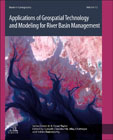
Applications of Geospatial Technology and Modeling for River Basin Management
Chandra Pal, Subodh
Chatterjee, Uday
Chakrabortty, Rabin
Applications of Geospatial Technology and Modeling for River Basin Management, Volume Twelve covers the use of multi-temporal satellite data for accurate estimations of different watershed features. It includes methods and case studies of the use of geographic information systems (GIS) as a valuable tool for criteria-based spatial analysis to manage natural resources and accurately simulate natural phenomena such as the hydrologic response of a watershed to precipitation and susceptibility to water erosion. The book also provides direction on many types of modelling and mapping techniques in geospatial environments based on river basin management challenges. This book will be a useful guide for academics, researchers, and practitioners involved in the use of geospatial technologies for river basin management, as well as those interested in environmental management and Earth surface geomorphology. Covers the use of geospatial technologies and modeling for effective management of river basinsIncludes methodology and detailed case studies showing real-world applications at a variety of scalesEmphasizes the importance of integrating geospatial tools in decision-making processes for sustainable water resource management INDICE: 1. Recent Development and Paradigm Shifts of River Basin Management2. Determination Of the Probabilities of Flood Events Using GIS-Based Empirical Models - A Case Study3. Human Influence on River Planforms in A Himalayan River System with Multi-Timescale River Channel Dynamics4. Geographical Appraisal of Basin Hydrological Phenomena Using Google Earth Engine5. New Methodological Approaches for Assessing Bank Erosion Risk and Its Utilization on A Tropical River6. Flood Hazard and Susceptibility Evaluation in Semi-Arid Environments7. Bottom-Up Multilevel Flood Hazard Mapping Using Integrated Inundation Modelling in Data-Scarce Rivers8. Climate Change Impact on Flood Frequency Using Geospatial Modelling and GCM Models9. Geospatial Technique-Based Mapping, Monitoring and Modeling of Flood Hazards to Support Risk Management10. Torrential Rainfall-Induced Flash Flood Susceptibility Mapping Using Statistical and Geospatial Modeling11. Changing Patterns in Drainage Basin Hydrology in The Age of Anthropocene12. Geospatial Modeling of Potential Soil Erosion Estimation for Sustainable Soil Conservation Planning and Management13. Meteorological And Agriculture Drought Monitoring Using GIS-Based Approaches14. Geospatial Technology and Sustainable Agricultural Water Resources Management15. Land Suitability Modeling for Agricultural Sustainability16. Monitoring Of Land Degradation and Desertification Using State-Of-The-Art Methods and Remote Sensing Data Case Study17. Application Of Geospatial Technology and Data Driven Models in Terrain Characterization Using Terrain Modeling18. Gully Erosion Susceptibility Mapping Using Machine Learning Techniques Case Study19. Estimation Of Soil Erosion Risk and Vulnerable Zone Using RUSLE And GIS Approaches20. Zero Tillage Farming for Minimizing Topsoil Erosion and Sustainable Agriculture for River Basin Management21. Water Management Sustainability Evaluation at The River Basin Level Concept, Methodology, And Applications22. Sustainable River Basin Management Using GIS-Based Empirical Models23. Management And Modelling of Integrated Water Resources on Large Tropical River Basins24. Machine Learning Models Based on Remote Sensing and GIS For Spatial Gully Erosion Prediction25. Modeling Sustainable Environment in Riverine Ecosystem Using GIS-Based Machine Learning Models26. Risk and hazards mapping of Social-economic vulnerability of a drainage basin using GIS-based statistical techniques
- ISBN: 978-0-443-23890-1
- Editorial: Elsevier
- Encuadernacion: Rústica
- Páginas: 400
- Fecha Publicación: 01/09/2024
- Nº Volúmenes: 1
- Idioma: Inglés
